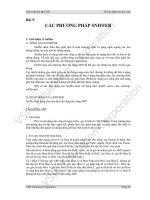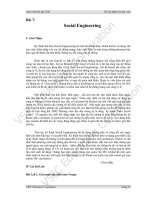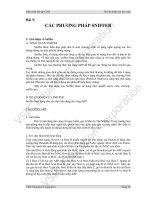south carolina science activity lab book
Bạn đang xem bản rút gọn của tài liệu. Xem và tải ngay bản đầy đủ của tài liệu tại đây (6.49 MB, 130 trang )
A2ALB_PE_TP_SK07.indd 1 11/7/06 4:11:06 PM
Instructions for Copying
Answers are printed in non-reproducible blue. Copy pages on a light
setting in order to make multiple copies for classroom use.
A2_ALB_FM_SK07.indd 2 11/7/06 7:07:20 PM
© M ac mi ll an /Mc Gr aw –Hill
iii
Activity Lab Book
Contents
LIFE SCIENCE
Chapter 1 Animals . . . . . . . . . . . . . . . . . . . . . . . . . . . . . . . . . . . . . . . . . . . . 7
Chapter 2 Looking at Habitats . . . . . . . . . . . . . . . . . . . . . . . . . . . . . . . .23
Chapter 3 Kinds of Habitats . . . . . . . . . . . . . . . . . . . . . . . . . . . . . . . . . .35
EARTH SCIENCE
Chapter 4 Observing Weather . . . . . . . . . . . . . . . . . . . . . . . . . . . . . . . .49
PHYSICAL SCIENCE
Chapter 5 Looking at Matter . . . . . . . . . . . . . . . . . . . . . . . . . . . . . . . . .63
Chapter 6 Changes in Matter . . . . . . . . . . . . . . . . . . . . . . . . . . . . . . . . .77
Chapter 7 Pushes, Pulls, and Magnets . . . . . . . . . . . . . . . . . . . . . . . . . 91
Everyday Science Activities . . . . . . . . . . . . . . . . . . . . . . . . . . . . . . . . . . . 107
Learning Labs . . . . . . . . . . . . . . . . . . . . . . . . . . . . . . . . . . . . . . . . . . . . . . . . 119
Teacher Notes for Everyday Science . . . . . . . . . . . . . . . . . . . . . . . . . . . 125
Teacher Notes for Learning Labs . . . . . . . . . . . . . . . . . . . . . . . . . . . . . . . 131
Materials List . . . . . . . . . . . . . . . . . . . . . . . . . . . . . . . . . . . . . . . . . . . . . . . . . 133
A2_ALB_FM_SK07.indd 3 11/7/06 7:07:21 PM
A2_ALB_FM_SK07.indd 4 11/7/06 7:07:21 PM
© M ac mi ll an /Mc Gr aw –Hill
Activity Lab Book
v
Science Safety Contract
Dear Parent or Guardian,
Today our science class talked about how to work safely when doing
laboratory experiments. It is important that you be informed regarding the
school’s effort to promote a safe environment for students participating in
laboratory activities. Please review the safety rules and this entire Safety
Contract with your child. This contract must be signed by both you and your
child in order for your child to participate in laboratory activities.
Safety Rules:
1. Listen carefully and follow directions.
2. If you are not sure about doing something, ask your teacher.
3. Never run or throw anything except as part of an activity.
4. Never taste anything when doing a science activity.
5. Always wash your hands before and after an activity.
6. Cooperate with others when working in a group.
7. Always clean up when you have fi nished.
Date: __________
I have read and reviewed the science safety rules
with my child. I consent to my child’s participation in
science laboratory activities in a classroom environment
where these rules are enforced.
Parent/Guardian signature:
I know that it is important to work safely in science
class. I understand the rules and will follow them.
Student signature:
A2_ALB_FM_SK07.indd 5 11/7/06 7:07:23 PM
© M ac mi ll an /Mc Gr aw –Hill
Guía de actividades de laboratorio
vi
Acuerdo de Seguridad para Ciencias
Estimados padres o tutor:
Hoy hemos hablado en nuestra clase de Ciencias sobre cómo mantener
la seguridad al realizar experimentos científi cos. Es importante que ustedes
estén informados del propósito de la escuela de promover un entorno
seguro para los estudiantes que participan en las prácticas de laboratorio.
Por favor, examinen cuidadosamente con su niño o niña las reglas siguientes
y el Acuerdo de Seguridad. El acuerdo debe ser fi rmado tanto por uno de
ustedes como por su niño o niña para que él o ella pueda participar en las
actividades de laboratorio.
Reglas de Seguridad:
1. Escucha con atención y sigue las indicaciones.
2. Si no estás seguro de algo pregúntale a tu maestro o maestra.
3. No corras ni arrojes ningún objeto a menos que sea parte de una actividad.
4. No te lleves nada a la boca ni lo pruebes cuando estés realizando una
actividad de ciencias.
5. Lávate siempre las manos antes y después de una actividad.
6. Coopera con tus compañeros cuando estés trabajando en grupo.
7. No te olvides de limpiar cuando hayas terminado una actividad.
Fecha: __________
He leído y examinado las reglas de seguridad de ciencias con
mi niño o niña. Doy mi consentimiento para su participación en
las actividades del laboratorio de ciencias en un entorno donde se
hagan cumplir estas reglas.
Firma de uno de los padres o tutor:
Sé la importancia que tiene trabajar con seguridad en la clase
de Ciencias. Comprendo las reglas y me comprometo a seguirlas.
Firma del estudiante:
A2_ALB_FM_SK07.indd 6 11/7/06 7:07:25 PM
Name
Date
Explore
How can a frog float
on a lily pad?
What to Do
&
Predict. Where should you place the
frog on the lily pad so that the frog
stays dry?
'
Make a Model. Color a paper plate green with
crayon. This will be the lily pad.
(
Be Careful. Poke a small hole near the
edge of the lily pad. Tie a six-inch piece of
string through the hole.
)
Place the lily pad in a pan of
water with the string below it.
• paper
plate
• green
crayon
• scissors
• string
• pan of
water
• toy frog
You need
1
© Macmillan/McGraw-Hill
Be a Scientist
Activity Lab Book
A2_ALB_FM_BAS_SK07.indd 1 11/7/06 7:08:58 PM
Name
Date
Explore
*
Record Data. Draw and write down where
you placed the frog.
2
© Macmillan/McGraw-Hill
Be a Scientist
Activity Lab Book
A2_ALB_FM_BAS_SK07.indd 2 11/7/06 7:09:06 PM
Alternative
Explore
Name
Date
You need
What can carry clay
on water?
In this activity, you will find something that
will float while carrying a small ball of clay.
What to Do
&
Predict. What do you think you can use to
carry a ball of clay on top of the water?
'
Look around the classroom and find an object
that you think will float in a pan of water.
(
Put the object you chose into a pan of water,
and place a ball of clay on top of it. Does the
object float or sink?
What Did You Find Out?
)
Why do you think your object was or was not
able to float?
• classroom
objects
• ball of clay
• pan of water
3
© Macmillan/McGraw-Hill
Be a Scientist
Activity Lab Book
A2_ALB_FM_BAS_SK07.indd 3 11/7/06 7:09:07 PM
Name
Date
Explore
How does a frog move?
What to Do
&
Observe. Look at the pictures on this page.
Think about how the frogs are moving.
'
Record Data. Make a list of the different ways
you see the frogs moving.
4
© Macmillan/McGraw-Hill
Be a Scientist
Activity Lab Book
A2_ALB_FM_BAS_SK07.indd 4 11/7/06 7:09:12 PM
Name
Date
Explore
(
Draw Conclusions. Add to your list. Write the
body part the frogs use to move in each way.
)
Communicate. How do frogs move?
5
© Macmillan/McGraw-Hill
Be a Scientist
Activity Lab Book
A2_ALB_FM_BAS_SK07.indd 5 11/7/06 7:09:17 PM
Alternative
Explore
Name
Date
What lives in or near a pond?
In this activity, you will find out what lives in
or near ponds.
What to Do
&
Observe. Look carefully at a picture of a pond.
'
Record Data. Write down what you observe
about what lives in or near ponds.
(
Communicate. Discuss with a partner what you
observed and the conclusions you drew about
what lives in or near a pond.
What Did You Find Out?
)
How did recording what you saw in the pictures
help you communicate your conclusions?
• photos of
ponds
You need
6
© Macmillan/McGraw-Hill
Be a Scientist
Activity Lab Book
A2_ALB_FM_BAS_SK07.indd 6 11/7/06 7:09:18 PM
Name
Date
Explore
How can we put animals
into groups?
What to Do
&
Classify. Look at the pictures of the animals.
Put the animals into groups. How did you
decide to group the animals?
'
Talk about the animal groups with a partner.
What groups did your partner use?
7
© Macmillan/McGraw-Hill
Chapter 1 • Animals Use with Lesson 1
Activity Lab Book Animal Groups
A2_ALB_C01_SK07.indd 7 11/6/06 8:58:24 AM
Name
Date
Explore
(
Compare. How are your groups and your
partner’s groups alike? How are they different?
Explore More
)
Classify. Think about animals that live on
land. How can you classify them?
8
© Macmillan/McGraw-Hill
Chapter 1 • Animals Use with Lesson 1
Activity Lab Book Animal Groups
A2_ALB_C01_SK07.indd 8 11/6/06 8:58:26 AM
Alternative
Explore
Name
Date
You need
• pictures of
animals
• pencil
How are animals the same
and different?
What to Do
&
Observe. Look carefully at a picture
of an animal and describe the animal to your
partner.
'
Compare.
Discuss how the
animals you and
your partner chose
are the same and
different. Record
the similarities and
differences in the
Venn diagram.
(
How do the parts of the animals you observed
help them survive? Where do the animals live?
Alike
DifferentDifferent
9
© Macmillan/McGraw-Hill
Chapter 1 • Animals Use with Lesson 1
Activity Lab Book Animal Groups
A2_ALB_C01_SK07.indd 9 11/6/06 8:58:28 AM
Name
Date
Quick Lab
Make an Animal Model
What to Do
&
Make a Model. Choose an animal
and use the art materials to make a
model of the animal. Be sure to show
important body parts that help the
animal meet its needs.
'
Communicate. Look at your
partner’s model. How do the parts
of the model show how the animal
meets its needs?
(
Compare your model to your partner’s model.
How are they alike? How are they different?
You need
• heavy paper
• colored paper
• shiny paper
• felt
• foil
• chenille sticks
• glue
• scissors
• tape
10
© Macmillan/McGraw-Hill
Chapter 1 • Animals Use with Lesson 1
Activity Lab Book Animal Groups
A2_ALB_C01_SK07.indd 10 11/6/06 8:58:29 AM
Focus on
Skills
Name
Date
Classify
When you classify, you put things into groups to
show how they are alike.
Learn It
You can use a chart to classify what you learned
about animals.
Try It
Use a chart like the one above to classify these
animals. Add other animals to your chart. Share
your chart with a partner.
11
© Macmillan/McGraw-Hill
Chapter 1 • Animals Use with Lesson 1
Activity Lab Book Animal Groups
A2_ALB_C01_SK07.indd 11 11/6/06 8:58:36 AM
Focus on
Skills
Name
Date
&
How are mammals and birds alike? How are
they different?
'
What ways did you classify the animals in your
chart?
(
Write About It. How is your chart different
from the chart your partner made?
12
© Macmillan/McGraw-Hill
Chapter 1 • Animals Use with Lesson 1
Activity Lab Book Animal Groups
A2_ALB_C01_SK07.indd 12 11/6/06 8:58:38 AM
Name
Date
Explore
How are babies and adults
alike and different?
What to Do
&
What are some things that babies do?
'
What are some things adults do?
13
© Macmillan/McGraw-Hill
Chapter 1 • Animals Use with Lesson 2
Activity Lab Book Animals Grow and Change
A2_ALB_C01_SK07.indd 13 11/6/06 8:58:40 AM
Name
Date
Explore
(
Compare. Make a Venn diagram to compare
babies to adults.
Explore More
)
How are baby humans and baby tigers alike
and different?
14
© Macmillan/McGraw-Hill
Chapter 1 • Animals Use with Lesson 2
Activity Lab Book Animals Grow and Change
A2_ALB_C01_SK07.indd 14 11/6/06 8:58:41 AM
Alternative
Explore
Name
Date
What do you observe about
babies and adults?
In this activity, you will observe and
compare baby and adult animals.
What to Do
&
Observe. Look carefully at the pictures of the
baby animals and describe what they look like
and what they are doing in the pictures.
'
Observe. Look carefully at the pictures of the
adult animals and observe what they look like
and what they are doing in the pictures.
(
Compare. How are some baby animals and
adult animals the same? How are they different?
• pictures of
adult animals
• pictures of
baby animals
You need
15
© Macmillan/McGraw-Hill
Chapter 1 • Animals Use with Lesson 2
Activity Lab Book Animals Grow and Change
A2_ALB_C01_SK07.indd 15 11/6/06 8:58:43 AM
Name
Date
Quick Lab
Act Out an Animal Life Cycle
What to Do
&
Work with your group to decide which
animal’s life cycle you want to act out.
'
Communicate. Which animal did you
choose? Which part of the life cycle are you
going to act out?
(
How do you plan to act out the part of the life
cycle you chose?
)
Compare. How are the life cycles of animals
the same and different?
• index cards
• yarn
You need
16
© Macmillan/McGraw-Hill
Chapter 1 • Animals Use with Lesson 2
Activity Lab Book Animals Grow and Change
A2_ALB_C01_SK07.indd 16 11/6/06 8:58:45 AM
Step
1
Step
2
Be a
Scientist
Name
Date
How does a mealworm grow?
Find out how a mealworm grows and
changes.
What to Do
&
Put some oatmeal in the container.
Poke holes in the lid.
'
Observe. What does a
mealworm look like? Use
your hand lens to observe
the mealworm. Place a
mealworm and an apple
slice in the container.
• oatmeal
• container
with lid
• hand lens
• mealworm
larva
• slice of
apple
• ruler
You need
17
© Macmillan/McGraw-Hill
Chapter 1 • Animals Use with Lesson 2
Activity Lab Book Animals Grow and Change
A2_ALB_C01_SK07.indd 17 11/6/06 8:58:52 AM
Name
Date
Inquiry
Investigation
(
Record Data. Measure your
mealworm every two days.
Remember to be gentle with the
mealworm. Write about how it
changed. Remember to wash your hands.
)
Predict. How long do you think your mealworm
will grow? How do you think it will change?
Investigate More
Compare. Observe another mealworm. How are
they alike and different?
18
© Macmillan/McGraw-Hill
Chapter 1 • Animals Use with Lesson 2
Activity Lab Book Animals Grow and Change
A2_ALB_C01_SK07.indd 18 11/6/06 8:58:53 AM
Step
1
Name
Date
Explore
You need
How does the color of
an animal keep it safe?
What to Do
&
Cut one piece of patterned paper into
eight shapes. Be Careful.
'
Put the eight shapes on the other sheet of
patterned paper.
(
Time your partner while he or she picks up the
shapes.
)
Now put the shapes on plain paper and time
your partner again.
• scissors
• 2 pieces of
patterned
paper
• stopwatch
• plain paper
19
© Macmillan/McGraw-Hill
Chapter 1 • Animals Use with Lesson 3
Activity Lab Book Staying Alive
A2_ALB_C01_SK07.indd 19 11/6/06 8:58:59 AM









